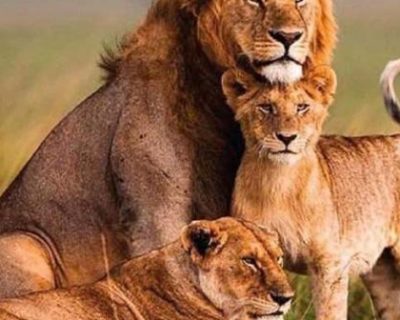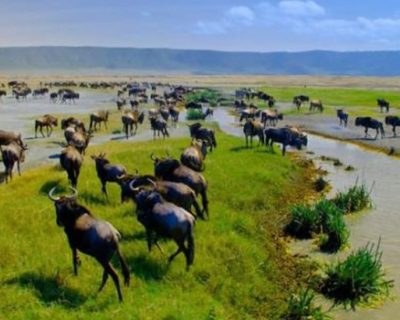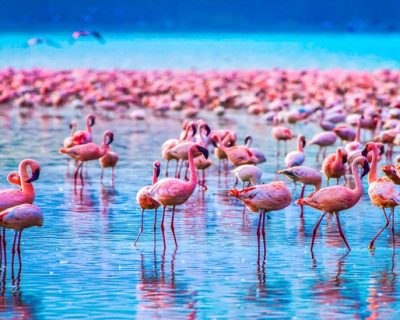Ngorongoro Conservation Area (NCA) is one of Tanzania’s most exceptional destinations, offering a perfect blend of natural beauty, wildlife, and rich cultural heritage. Located in the northern part of the country, it spans over 8,000 square kilometers and includes diverse ecosystems, from the lush highland forests and volcanic peaks to the open savannah and unique crater floors. This UNESCO World Heritage site is best known for the Ngorongoro Crater, often referred to as the “Eighth Wonder of the World” due to its stunning landscape and exceptional concentration of wildlife.
The Ngorongoro Crater – A Natural Paradise
At the heart of the conservation area lies the Ngorongoro Crater, a massive, collapsed volcano that creates one of the most breathtaking views on earth. The caldera’s floor is a fertile haven, supporting an abundance of wildlife year-round. With its rich grasslands, swamps, and forests, the crater is home to a variety of animals, including elephants, lions, zebras, buffaloes, and cheetahs, as well as endangered species like the black rhino. Its compact size means animals are often found in large concentrations, providing incredible game viewing opportunities throughout the day.
The crater is also home to a wide variety of birdlife, including flamingos, ostriches, and migratory species that flock to its soda lakes and grasslands. The terrain within the crater is as diverse as it is captivating, from the lush forests on the crater rim to the open plains and salt flats on the crater floor, creating one of the most unique landscapes for both wildlife and photography.
Beyond the Crater – Diverse Landscapes and Wildlife
While the Ngorongoro Crater is the area’s centerpiece, the wider conservation area offers a diverse range of landscapes and experiences. The Ngorongoro Highlands are dotted with lush forests, waterfalls, and small lakes, making them a fantastic spot for walking safaris, birdwatching, and photography. The open grasslands surrounding the crater offer incredible opportunities for spotting large herds of wildebeest, gazelles, and the predators that follow them, including lions, leopards, and hyenas.
In addition to its well-known wildlife, Ngorongoro is a vital corridor for the Great Migration. Each year, thousands of wildebeest, zebras, and gazelles move through the conservation area, following the rains in search of fresh grazing areas. This natural spectacle can be seen on the outer edges of the crater, where large herds gather.
Maasai People and Cultural Heritage
What truly sets Ngorongoro apart is its unique human-wildlife coexistence. The area is not just a sanctuary for animals but also a living space for the Maasai people, who have called the region home for centuries. The Maasai continue to practice their traditional way of life, herding cattle, farming, and living in harmony with the wildlife. Visitors can engage with the Maasai through cultural tours, learning about their customs, traditions, and the spiritual significance they place on the land and animals.
The Maasai villages (enkangs) within the conservation area offer opportunities to experience their daily life, from dances and songs to the art of bead-making and crafts. The Maasai’s role in conservation, alongside the Tanzanian government, has been vital in maintaining the balance between preserving the wildlife and respecting the Maasai’s pastoral lifestyle.
Activities in Ngorongoro Conservation Area
- Game Drives: The Ngorongoro Crater and surrounding areas offer some of the best game-viewing opportunities in Tanzania. A guided game drive through the crater gives visitors a chance to see the Big Five and other wildlife up close, including rare species like the black rhino.
- Walking Safaris: For those seeking a more intimate experience, guided walking safaris through the Ngorongoro Highlands allow you to explore the area’s diverse flora and fauna while learning about the ecosystem from expert Maasai guides.
- Cultural Visits: Immerse yourself in the Maasai way of life by visiting local villages. Learn about their culture, traditions, and how they co-exist with the wildlife in the conservation area.
- Bird Watching: With over 500 bird species, Ngorongoro is a birdwatcher’s paradise. You’ll find a wide range of birds in the crater, including flamingos, ostriches, and raptors.
Best Time to Visit
Ngorongoro Conservation Area is a year-round destination. However, the dry season (June to October) is considered the best time for wildlife viewing as animals gather around the waterholes and are easier to spot. The wet season (November to May) is perfect for birdwatchers and those interested in seeing the lush greenery of the area, as well as witnessing calving season when thousands of wildebeest, zebras, and gazelles are born.
Accommodation Options
The Ngorongoro Conservation Area offers a range of accommodation options, from luxurious lodges on the crater rim with panoramic views to tented camps that provide a more authentic, close-to-nature experience. Many accommodations are strategically located to offer easy access to the crater floor and surrounding wildlife areas. Whether you prefer the comfort of a lodge or the adventure of a mobile camp, there are choices for all types of travelers.
Why Visit Ngorongoro Conservation Area?
Ngorongoro is a destination where natural beauty, diverse wildlife, and cultural heritage come together to create a once-in-a-lifetime experience. Whether you’re looking for spectacular wildlife sightings, breathtaking landscapes, or a deeper understanding of Maasai culture, Ngorongoro offers an unforgettable adventure that combines the best of Tanzania’s wilderness.
Join us at Ufana Safaris for a journey into this incredible conservation area, where nature, culture, and history intertwine in one of the world’s most spectacular settings.
best Ngorongoro itinerary

3-Day Ngorongoro Safari
from $1559
Explore the Ngorongoro Crater’s wildlife with a full day of game drives to spot the Big Five. On the second day, enjoy a guided walk through the Ngorongoro Highlands and a visit to a Maasai village. This short trip offers a blend of wildlife, landscapes, and local culture.

4-Day Ngorongoro and Serengeti Safari
from $1559
Spend two days exploring the Ngorongoro Crater, including a full-day game drive and a visit to the Maasai Highlands. Then, transfer to Serengeti for two more days of thrilling wildlife viewing, with a chance to see the Great Migration. This itinerary combines the best of both parks.

5-Day Ngorongoro and Tarangire Safari
from $1559
Start with a two-day exploration of Ngorongoro, including game drives in the crater and a cultural visit to the Maasai villages. Then head to Tarangire for two days of game drives, famous for its large elephant herds and unique baobab trees. This itinerary offers diverse wildlife experiences.

